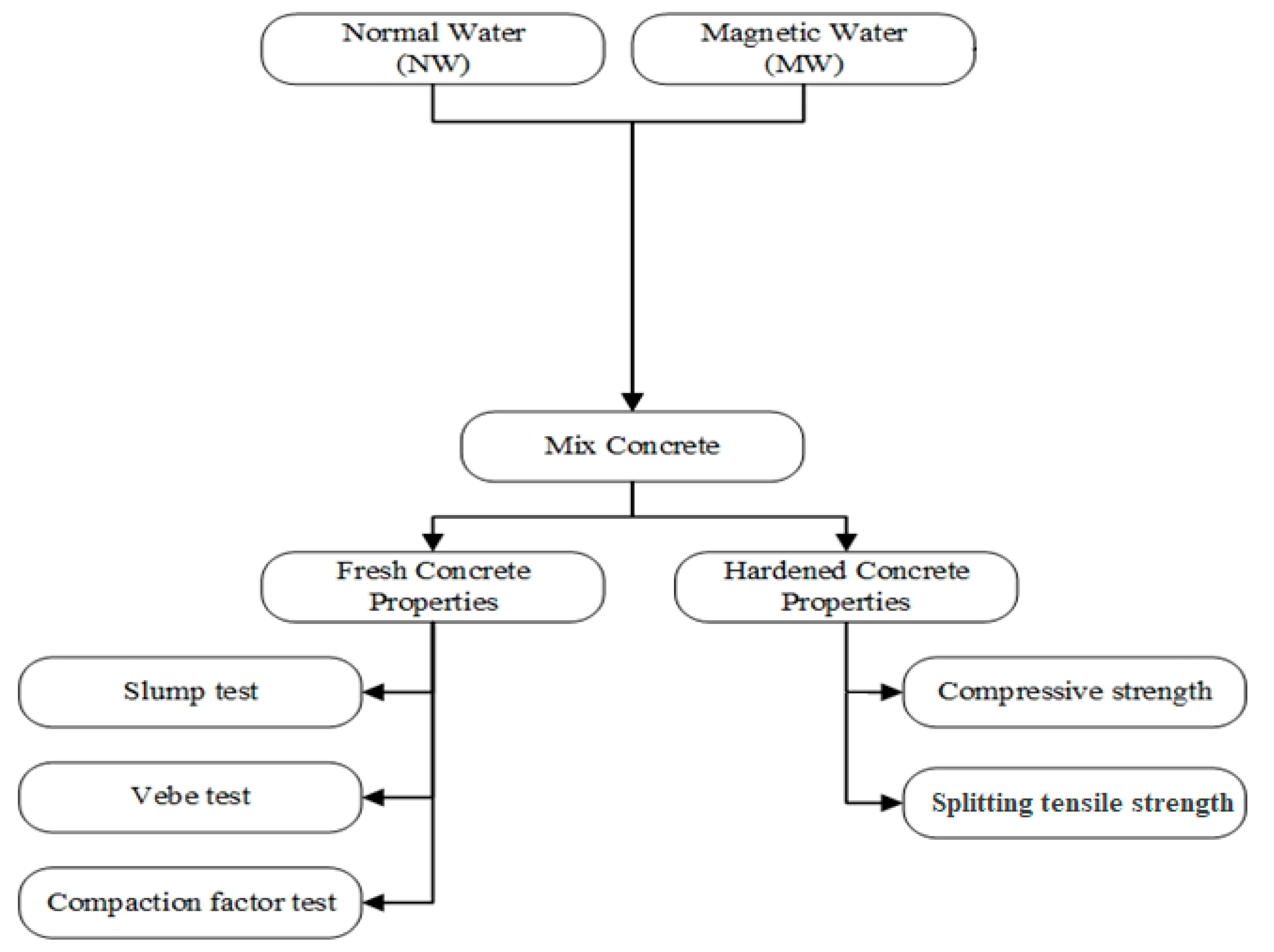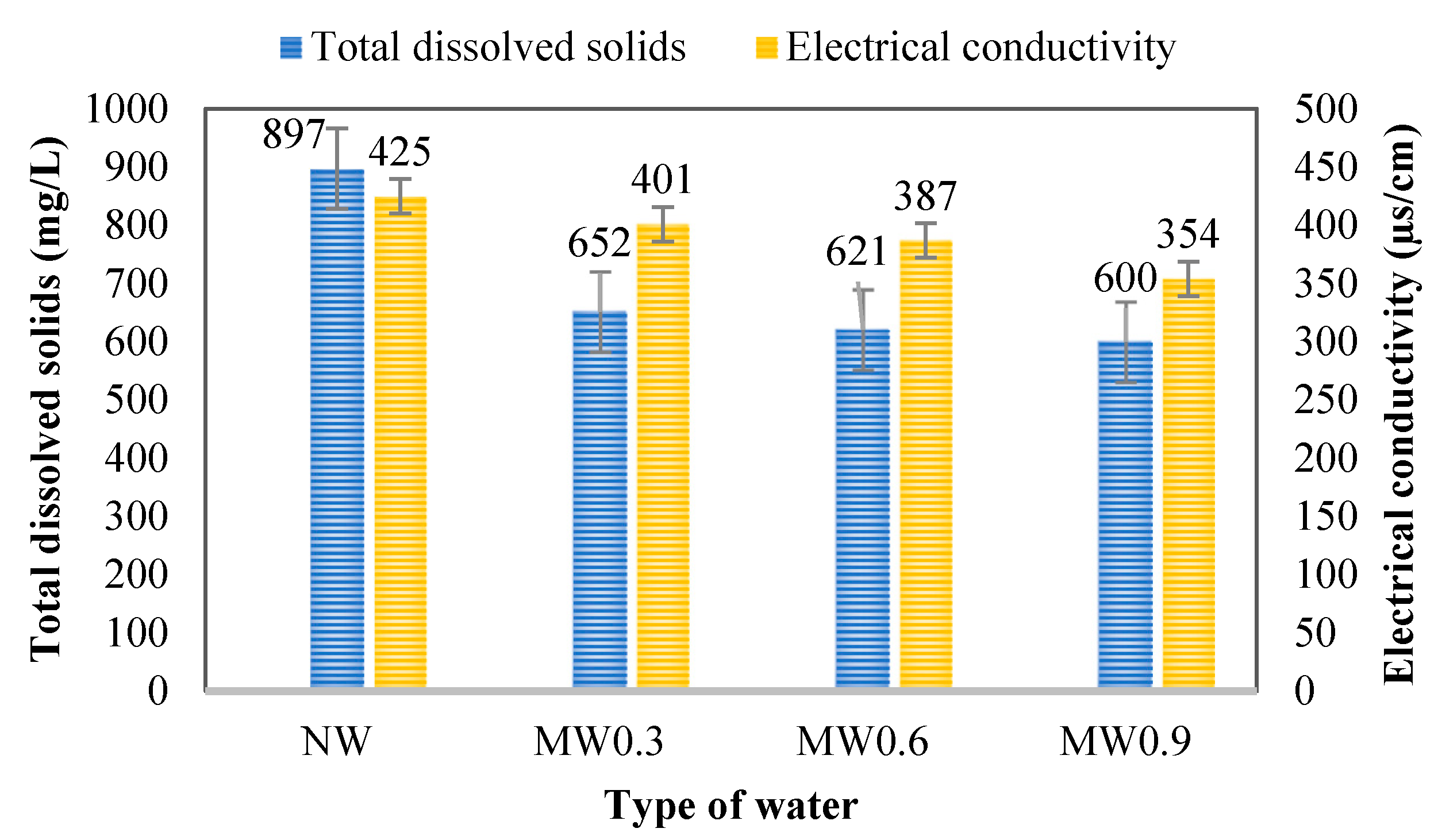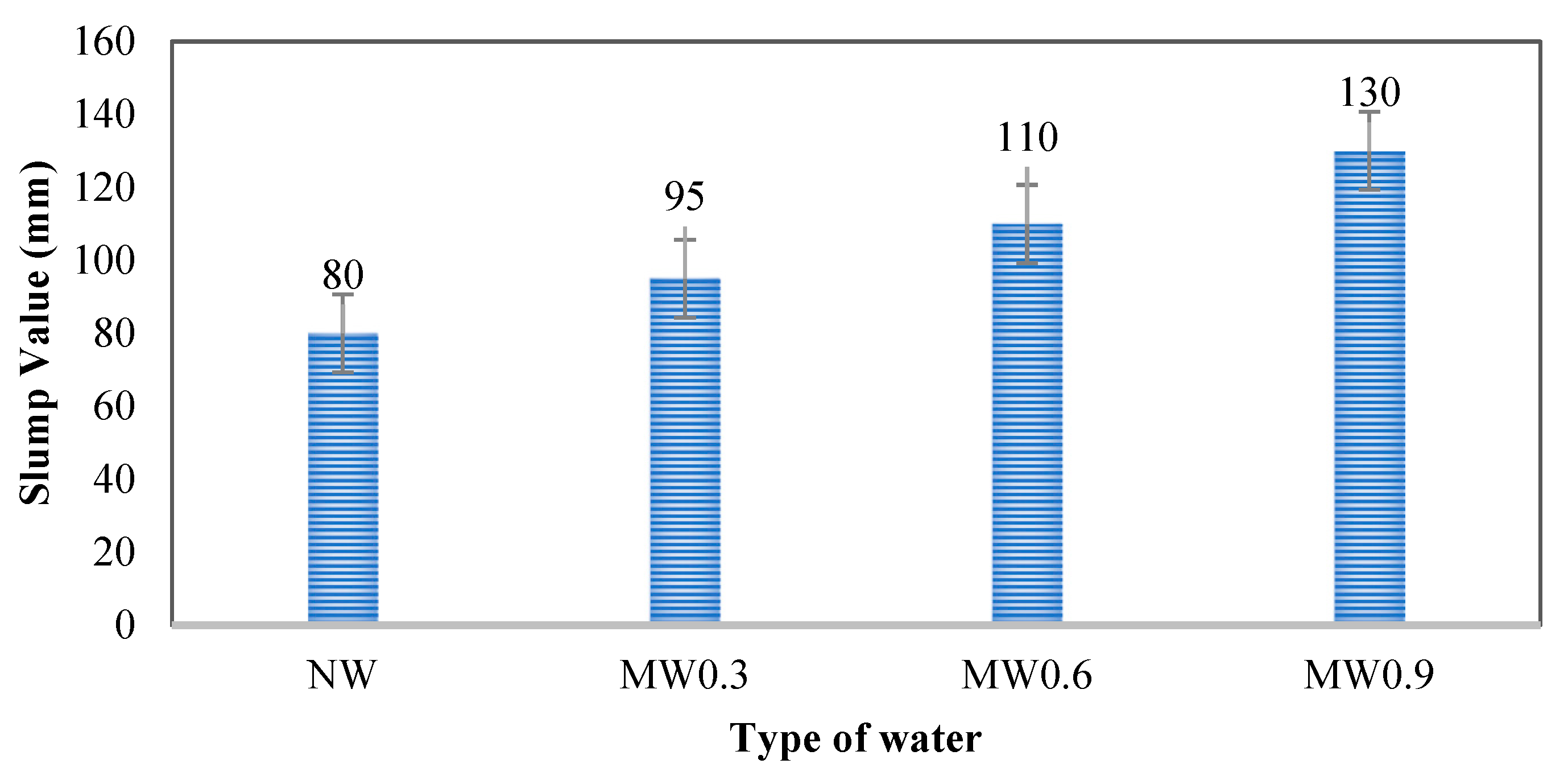Investigation of the Effect of Magnetic Water and Polyethylene Fiber Insertion in Concrete Mix
Abstract
:1. Introduction
2. Materials and Methods
2.1. Materials
2.1.1. Physical and Chemical Properties of Water
Electrical Conductivity and Total Dissolved Solids
pH Meter
2.1.2. Properties of Concrete
2.1.3. Microstructure Characterization of Concrete
2.2. Methods
2.3. Properties for Fresh Concrete
2.3.1. Slump Test
2.3.2. Compaction Factor Test
2.3.3. Vebe Test
2.4. Properties for Hardened Concrete
2.4.1. Compressive Strength
2.4.2. Splitting Tensile Strength
3. Results and Discussion
3.1. Concrete Physical and Chemical Properties of Water
3.1.1. Electrical Conductivity and Total Dissolved Solids
3.1.2. pH Meter
3.2. Properties for Fresh Concrete
3.2.1. Slump Test
3.2.2. Compaction Factor Test
3.2.3. Vebe Time Test
3.3. Properties for Hardened Concrete
3.3.1. Compressive Strength Test
3.3.2. Splitting Tensile Strength Test
3.4. Microstructure Characterization of Concrete
4. Conclusions
- It was noticed that the absorption of MW crystals revealed greater molecular integrity inside the crystal. It was also found that the TDS and EC values fell by 33.1% and 16.7%, respectively, after applying the magnetic field of strength 0.9 Tesla.
- Hence, the concrete’s workability increased. Increasing the slump value of concrete using MWC assisted in adjusting the cement-to-water ratio, hence decreasing the cement content of the concrete. This study concludes that the compressive strength of the MWC grew by 32.9% in comparison to the NWC and that the MW attained the 28-day strength of the NWC in only 21 days.
- In addition, investigations showed that when the qualities of the MW were improved, cement hydration and workability-related parameters were also improved. Using FTIR research, the hydration products of the NW and MW0.9 concrete mixes were analyzed. In conclusion, it was discovered that the use of the MW for mixing concrete enhanced the physiochemical qualities of fresh and hardened concrete with little water use and curing time.
- Due to water magnetization, the quality of water in the concrete industry improves, which directly improves the quality and life span of structures. The need for magnetic water concreting is urgent, and there is a significant demand to construct sustainable building structures with reduced usage of potable water, thereby increasing the construction industry’s sustainability.
Funding
Institutional Review Board Statement
Informed Consent Statement
Data Availability Statement
Conflicts of Interest
References
- Fu, W.; Wang, Z.B. The New Technology of Concrete Engineering; The Publishing House of Chinese Architectural Industry: Beijing, China, 1994; pp. 56–59. [Google Scholar]
- Hover, K.C. The Influence of Water on the Performance of Concrete. Constr. Build. Mater. 2011, 25, 3003–3013. [Google Scholar] [CrossRef]
- Wei, H.; Wang, Y.; Luo, J. Influence of Magnetic Water on Early-Age Shrinkage Cracking of Concrete. Constr. Build. Mater. 2017, 147, 91–100. [Google Scholar] [CrossRef]
- Saleh, F.K.; Rivera, R.; Salehi, S.; Teodoriu, C.; Ghalambor, A. How Does Mixing Water Quality Affect Cement Properties. In Proceedings of the SPE International Conference and Exhibition on Formation Damage Control, Lafayette, LA, USA, 7–9 February 2018. [Google Scholar] [CrossRef]
- Esfahani, A.R.; Reisi, M.; Mohr, B. Magnetized Water Effect on Compressive Strength and Dosage of Superplasticizers and Water in Self-Compacting Concrete. J. Mater. Civ. Eng. 2018, 30, 04018008. [Google Scholar] [CrossRef]
- Esmaeilnezhad, E.; Choi, H.J.; Schaffie, M.; Gholizadeh, M.; Ranjbar, M. Characteristics and Applications of Magnetized Water as a Green Technology. J. Clean. Prod. 2017, 161, 908–921. [Google Scholar] [CrossRef]
- Zhou, K.X.; Lu, G.W.; Zhou, Q.C.; Song, J.H.; Jiang, S.T.; Xia, H.R. Monte Carlo Simulation of Liquid Water in a Magnetic Field. J. Appl. Phys. 2000, 88, 1802–1805. [Google Scholar] [CrossRef]
- Toledo, E.J.L.; Ramalho, T.C.; Magriotis, Z.M. Influence of Magnetic Field on Physical–Chemical Properties of the Liquid Water: Insights from Experimental and Theoretical Models. J. Mol. Struct. 2008, 888, 409–415. [Google Scholar] [CrossRef]
- Ahmed, H.I. Behavior of Magnetic Concrete Incorporated with Egyptian Nano Alumina. Constr. Build. Mater. 2017, 150, 404–408. [Google Scholar] [CrossRef]
- Su, N.; Wu, Y.H.; Mar, C.Y. Effect of Magnetic Water on the Engineering Properties of Concrete Containing Granulated Blast-Furnace Slag. Cem. Concr. Res. 2000, 30, 599–605. [Google Scholar] [CrossRef]
- Gholhaki, M.; kheyroddin, A.; Hajforoush, M.; Kazemi, M. An Investigation on the Fresh and Hardened Properties of Self-Compacting Concrete Incorporating Magnetic Water with Various Pozzolanic Materials. Constr. Build. Mater. 2018, 158, 173–180. [Google Scholar] [CrossRef]
- Su, N.; Wu, C.F. Effect of Magnetic Field Treated Water on Mortar and Concrete Containing Fly Ash. Cem. Concr. Compos. 2003, 25, 681–688. [Google Scholar] [CrossRef]
- Faris, A.S.; Al-Mahaidi, R.; Jadooe, A. Implementation of Magnetized Water to Improve the Properties Of. Int. J. Civ. Eng. Technol. 2014, 5, 43–57. [Google Scholar]
- Colic, M.; Morse, D. The Elusive Mechanism of the Magnetic ‘Memory’ of Water. Colloids Surf. A Physicochem. Eng. Asp. 1999, 154, 167–174. [Google Scholar] [CrossRef]
- Pang, X.-F.; Zhu, X.-C. The Magnetization of Water Arising from a Magnetic-Field and Its Applications in Concrete Industry. Int. J. Eng. Res. Appl. 2013, 3, 1541–1552. [Google Scholar]
- Yu, K.Q.; Yu, J.T.; Dai, J.G.; Lu, Z.D.; Shah, S.P. Development of Ultra-High Performance Engineered Cementitious Composites Using Polyethylene (PE) Fibers. Constr. Build. Mater. 2018, 158, 217–227. [Google Scholar] [CrossRef]
- Fraternali, F.; Spadea, S.; Berardi, V.P. Effects of Recycled PET Fibres on the Mechanical Properties and Seawater Curing of Portland Cement-Based Concretes. Constr. Build. Mater. 2014, 61, 293–302. [Google Scholar] [CrossRef]
- Yu, J.; Yao, J.; Lin, X.; Li, H.; Lam, J.Y.K.; Leung, C.K.Y.; Sham, I.M.L.; Shih, K. Tensile Performance of Sustainable Strain-Hardening Cementitious Composites with Hybrid PVA and Recycled PET Fibers. Cem. Concr. Res. 2018, 107, 110–123. [Google Scholar] [CrossRef]
- Yao, J.; Leung, C.K.Y. A New Physical Model for Empirical Fiber Snubbing Effect in Cementitious Composites Based on Large Deflection Beam Theory. Cem. Concr. Compos. 2019, 96, 238–251. [Google Scholar] [CrossRef]
- Li, V.C.; Leung, C.K.Y. SteadyState and Multiple Cracking of Short Random Fiber Composites. J. Eng. Mech. 1992, 118, 2246–2264. [Google Scholar] [CrossRef] [Green Version]
- Lu, C.; Li, V.C.; Leung, C.K.Y. Flaw Characterization and Correlation with Cracking Strength in Engineered Cementitious Composites (ECC). Cem. Concr. Res. 2018, 107, 64–74. [Google Scholar] [CrossRef]
- Al-Maliki, A.A.K.; Aswed, K.K.; Abraheem, A.K. Properties of Concrete with Magnetic Mixing Water. AIP Conf. Proc. 2020, 2213, 020146. [Google Scholar] [CrossRef]
- Ramezanianpour, A.A.; Sivasundaram, V.; Malhotra, V.M. Superplasticizers: Their effect on the strength properties of concrete. Concr. Int. 1995, 17, 30–36. [Google Scholar]
- Chan, N.; Young-Rojanschi, C.; Li, S. Effect of Water-to-Cement Ratio and Curing Method on the Strength, Shrinkage and Slump of the Biosand Filter Concrete Body. Water Sci. Technol. 2018, 77, 1744–1750. [Google Scholar] [CrossRef] [PubMed] [Green Version]
- Abdel-Magid, T.I.M.; Hamdan, R.M.; Abdelgader, A.A.B.; Omer, M.E.A.; Ahmed, N.M.R.A. Effect of Magnetized Water on Workability and Compressive Strength of Concrete. Procedia Eng. 2017, 193, 494–500. [Google Scholar] [CrossRef]
- Sabapathy, Y.; Sooraj, K.; Krishna, K.S.L.; Nithish, V.; Varadan, S.V. A Study on Influence of Magnetic Water on the Strength Characteristics of Concrete. Res. J. Pharm. Biol. Chem. Sci. 2019, 10, 247–253. [Google Scholar]
- Ebrahimi Jouzdani, B.; Reisi, M. Effect of Magnetized Water Characteristics on Fresh and Hardened Properties of Self-Compacting Concrete. Constr. Build. Mater. 2020, 242, 118196. [Google Scholar] [CrossRef]
- Hajforoush, M.; Kheyroddin, A.; Rezaifar, O. Investigation of Engineering Properties of Steel Fiber Reinforced Concrete Exposed to Homogeneous Magnetic Field. Constr. Build. Mater. 2020, 252, 119064. [Google Scholar] [CrossRef]
- Ahmed, S.M.; Manar, D.F. Effect of Static Magnetic Field Treatment on Fresh Concrete and Water Reduction Potential. Case Stud. Constr. Mater. 2021, 14, e00535. [Google Scholar] [CrossRef]
- Hassan, S.M.; Abdul Rahman, R. Effects of Exposure to Magnetic Field on Water Properties and Hatchability of Artemia Salina. APPN J. Agric. Biol. Sci. 2016, 11, 416–423. [Google Scholar]
- JS 286:20185; Water—Drinking Water. Jordan Standards and Metrology Organization: Amman, Jordan, 2008.
- Hasaani, A.S.; Hadi, Z.L.; Rasheed, K.A. Experimental Study of the Interaction of Magnetic Fields with Flowing Water. Int. J. Basic Appl. Sci. 2015, 3, 1–8. [Google Scholar]
- MasterFiber ® 012; Monofilament Polypropylene Fibres for Cementitious Systems, BASF Construction Chemicals. Master Builders Solutions: Dubai, UAE, 2020.
- BS EN 197-1:2011; Cement—Composition, Specifications and Conformity Criteria for Common Cements. British Standards: London, UK, 2011.
- ASTM C127-07; Standard Test Method for Density, Relative Density (Specific Gravity), and Absorption of Coarse Aggregate, Annual Book of ASTM Standards, ASTM International. American National Standards Institute: West Conshohocken, PA, USA, 2007.
- ASTM C 128—04a; Standard Test Method for Density, Relative Density (Specific Gravity), and Absorption of Fine Aggregate, Annual Book of ASTM Standards, ASTM International. American National Standards Institute: West Conshohocken, PA, USA, 2004.
- ASTM C136/C136M—14; Standard Test Method for Sieve Analysis of Fine and Coarse Aggregates, Annual Book of ASTM Standards, ASTM International. American National Standards Institute: West Conshohocken, PA, USA, 2014.
- ASTM C143/C143M—03; Standard Test Method for Slump of Hydraulic-Cement Concrete, Annual Book of ASTM Standards, ASTM International. American National Standards Institute: West Conshohocken, PA, USA, 2003.
- BS EN 12350-4:2019; Testing Fresh Concrete: Part 4 Degree of Compactability. British Standards: London, UK, 2019.
- ASTM C1170-06; Standard Test Method for Determining Consistency and Density of Roller-Compacted Concrete Using a Vibrating Table, Annual Book of ASTM Standards, ASTM International. American National Standards Institute: West Conshohocken, PA, USA, 2006.
- ASTM C496-96; Standard Test Method for Splitting Tensile Strength of Cylindrical Concrete Specimens. Annual Book of ASTM Standards, ASTM International. American National Standards Institute: West Conshohocken, PA, USA, 2007.
- Mohammed, M.; Alkhazan, K.; Ali, A.; Saddiq, N. The Effect of Magnetic Field on the Physical, Chemical and Microbiological Properties of the Lake Water in Saudi Arabia. J. Evol. Biol. Res. 2010, 2, 7–14. [Google Scholar]
- Brameshuber, W.; Raupach, M.; Schröder, P.; Dauberschmidt, C. Non-Destructive Determination of the Water-Content in the Concrete Cover Using the Multiring-Electrode. In Proceedings of the International Symposium (NDT-CE 2003) Non-Destructive Testing in Civil Engineering, Berlin, Germany, 16–19 September 2003. [Google Scholar]
- ben Amor, H.; Elaoud, A.; Hozayn, M.; Beguinot, J. Does Magnetic Field Change Water PH? Asian Res. J. Agric. 2018, 8, 1–7. [Google Scholar] [CrossRef]
- Čolić, M.; Chien, A.; Morse, D. Synergistic Application of Chemical and Electromagnetic Water Treatment in Corrosion and Scale Prevention. Croat. Chem. Acta 1998, 71, 132428. [Google Scholar]
- Parsons, S.A.; Judd, S.J.; Stephenson, T.; Udol, S.; Wang, B.L. Magnetically Augmented Water Treatment. Process Saf. Environ. Prot. 1997, 75, 98–104. [Google Scholar] [CrossRef] [Green Version]
- Parsons, S.A.; Wang, B.L.; Judd, S.J.; Stephenson, T. Magnetic Treatment of Calcium Carbonate Scale—Effect of PH Control. Water Res. 1997, 31, 339–342. [Google Scholar] [CrossRef]
- Saghiri, M.A.; Garcia-Godoy, F.; Asatourian, A.; Lotfi, M.; Banava, S.; Khezri-Boukani, K. Effect of PH on Compressive Strength of Some Modification of Mineral Trioxide Aggregate. Med. Oral Patol. Oral Cirugía Bucal 2013, 18, e714–e720. [Google Scholar] [CrossRef]
- Çomak, B. Effects of Use of Alkaline Mixing Waters on Engineering Properties of Cement Mortars. Eur. J. Environ. Civ. Eng. 2016, 22, 736–754. [Google Scholar] [CrossRef]
- Siva Konda Reddy, B.; Ghorpade, D.G.; Rao, D. Effect of magnetic field exposure time on workability and compressive strength of magnetic water concrete. Int. J. Adv. Eng. Technol. 2013, 4, 120–122. [Google Scholar]
- Malathy, R.; Karuppasamy, N.; Adithya, V.; Gokulapriya, P. Influence of Magnetic Water on Properties of Concrete Paver Blocks. Lect. Notes Civ. Eng. 2021, 78, 327–336. [Google Scholar] [CrossRef]
- Malathy, R.; Narayanan, K.; Mayakrishnan, P. Performance of Prestressed Concrete Beams Using Magnetic Water for Concrete Mixing. J. Adhes. Sci. Technol. 2021, 36, 666–684. [Google Scholar] [CrossRef]
- Zhao, K.; Zhang, P.; Wang, B.; Tian, Y.; Xue, S.; Cong, Y. Preparation of Electric- and Magnetic-Activated Water and Its Influence on the Workability and Mechanical Properties of Cement Mortar. Sustainability 2021, 13, 4546. [Google Scholar] [CrossRef]
- Reddy, B.S.K.; Ghorpade, V.G.; Rao, H.S. Influence of Magnetic Water on Strength Properties of Concrete. Indian J. Sci. Technol. 2014, 7, 14–18. [Google Scholar] [CrossRef]
- Pacheco Torgal, F.; Castro-Gomes, J.P. Influence of Physical and Geometrical Properties of Granite and Limestone Aggregates on the Durability of a C20/25 Strength Class Concrete. Constr. Build. Mater. 2006, 20, 1079–1088. [Google Scholar] [CrossRef]
- Zhu, Y.; Yan, L.; Cao, Z.; We, L.; Chen, Z. Physical and Chemical Properties of Magnetized Water. J. Hunan Univ. 1999, 26, 21–25, 32. [Google Scholar]
- Afshin, H.; Gholizadeh, M.; Khorshidi, N. Improving Mechanical Properties of High Strength Concrete by Magnetic Water Technology. Trans. A Civ. Eng. 2010, 17, 74–79. [Google Scholar]
- Bharath, S.; Subraja, S.; Kumar, P.A. Influence of Magnetized Water on Concrete by Replacing Cement Partially with Copper Slag. J. Chem. Pharm. Sci. 2016, 9, 2791–2795. [Google Scholar]
- Yousry, O.M.M.; Abdallah, M.A.; Ghazy, M.F.; Taman, M.H.; Kaloop, M.R. A Study for Improving Compressive Strength of Cementitious Mortar Utilizing Magnetic Water. Materials 2020, 13, 1971. [Google Scholar] [CrossRef] [Green Version]
- Ghorbani, S.; Gholizadeh, M.; de Brito, J. Effect of Magnetized Water on the Mechanical and Durability Properties of Concrete Block Pavers. Materials 2018, 11, 1647. [Google Scholar] [CrossRef] [PubMed] [Green Version]
- Mghaiouini, R.; Graich, A.; Elaoud, A.; Garmim, T.; Belghiti, M.; Benzbiria, N.; Hozayn, M.; Monkade, M.; el Bouari, A. Formulation and Physico-Mechanical Characterization of an Eco-Mortar Composite Based on Bottom Ash and Magnetized Water. Indian J. Sci. Technol. 2020, 13, 1172–1187. [Google Scholar] [CrossRef]









| Parameter | Normal Water (NW) | Magnetic Water (MW) | Standard Values | ||
|---|---|---|---|---|---|
| 0.3 T | 0.6 T | 0.9 T | |||
| Total dissolved solids (mg/L) | 897 | 652 | 621 | 600 | ≤1000 |
| Electrical conductivity (µs/cm) | 425 | 401 | 387 | 354 | |
| pH | 7.89 | 7.99 | 8.24 | 8.37 | 6.5–8.5 |
| Mix ID | Water Type | Magnetic Field (Tesla) | Percentage of Fibers (%) |
|---|---|---|---|
| NW | Normal | 0 | 0 |
| MW0.3 | Magnetized | 0.3 | 0.3 |
| MW0.6 | Magnetized | 0.6 | 0.6 |
| MW0.9 | Magnetized | 0.9 | 0.9 |
| Physical Requirements | Results | Standard Values |
|---|---|---|
| Specific Gravity | 3.08 | 3.15 |
| Fineness (Blaine) cm2/g | 4750 | - |
| Soundness (Expansion) mm | 3.5 | ≤10 |
| Initial Setting Time (min) | 148 | ≥60 |
| Final Setting Time (min) | 287 | - |
| Chemical Composition | Test Value (%) |
|---|---|
| Loss on Ignition (LOI) | 1.55 |
| Insoluble Residue | 7.50 |
| MgO | 4.75 |
| SO3 | 3.06 |
| Chloride Content | 0.03 |
| CaO | 53.8 |
| SiO2 | 23.5 |
| Al2O3 | 6.30 |
| Fe2O3 | 2.00 |
| K2O | 0.85 |
| Free Lime | 1.85 |
| Type of Test | Coarse Aggregate | Fine Aggregate |
|---|---|---|
| Specific Gravity | 2.758 | 2.585 |
| Water Absorption (%) | 0.682 | 0.785 |
| Fineness Modulus Combined (%) | 3.00 | |
| Sieve Opening (mm) | Combined Gradation Mix (%) |
|---|---|
| 38.0 | 100 |
| 25 | 100 |
| 19.5 | 96.9 |
| 9.5 | 55.9 |
| 4.75 | 38.8 |
| 2.36 | 35.8 |
| 1.18 | 28.9 |
| 0.600 | 24.8 |
| 0.300 | 14.7 |
| 0.150 | 4.2 |
| 0.075 | 3.8 |
| Mix Identity # (Mix ID) | Total Water (kg/m3) | Coarse Aggregate (kg/m3) | Fine Aggregate (kg/m3) | Cement (kg/m3) |
|---|---|---|---|---|
| NW | 155 | 1200 | 800 | 420 |
| MW0.3 | 155 | 1200 | 800 | 420 |
| MW0.6 | 155 | 1200 | 800 | 420 |
| MW0.9 | 155 | 1200 | 800 | 420 |
Disclaimer/Publisher’s Note: The statements, opinions and data contained in all publications are solely those of the individual author(s) and contributor(s) and not of MDPI and/or the editor(s). MDPI and/or the editor(s) disclaim responsibility for any injury to people or property resulting from any ideas, methods, instructions or products referred to in the content. |
© 2023 by the author. Licensee MDPI, Basel, Switzerland. This article is an open access article distributed under the terms and conditions of the Creative Commons Attribution (CC BY) license (https://creativecommons.org/licenses/by/4.0/).
Share and Cite
Alkhrissat, T. Investigation of the Effect of Magnetic Water and Polyethylene Fiber Insertion in Concrete Mix. J. Compos. Sci. 2023, 7, 303. https://doi.org/10.3390/jcs7070303
Alkhrissat T. Investigation of the Effect of Magnetic Water and Polyethylene Fiber Insertion in Concrete Mix. Journal of Composites Science. 2023; 7(7):303. https://doi.org/10.3390/jcs7070303
Chicago/Turabian StyleAlkhrissat, Tariq. 2023. "Investigation of the Effect of Magnetic Water and Polyethylene Fiber Insertion in Concrete Mix" Journal of Composites Science 7, no. 7: 303. https://doi.org/10.3390/jcs7070303






